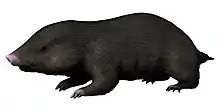| Dvinia | |
|---|---|
 | |
| Restoration of Dvinia prima | |
| Scientific classification | |
| Domain: | Eukaryota |
| Kingdom: | Animalia |
| Phylum: | Chordata |
| Clade: | Synapsida |
| Clade: | Therapsida |
| Clade: | Cynodontia |
| Family: | †Dviniidae Tatarinov, 1968 |
| Genus: | †Dvinia Amalitskii, 1922 |
| Species: | †D. prima |
| Binomial name | |
| †Dvinia prima Amalitskii, 1922 | |
Dvinia is an extinct genus of cynodonts found in the Salarevo Formation of Sokolki on the Northern Dvina River near Kotlas in Arkhangelsk Oblast, Russia. It is the only known member of the family Dviniidae. Its fossil remains date from the Late Permian and were found with Inostrancevia, Scutosaurus and Vivaxosaurus.
Dvinia was a small omnivore possessing a large temporal opening typical of advanced therapsids, with a thin postorbital bar separating the eye from the muscle attachment. As a cynodont, it was closely related to mammals. The dentition consisted of a set of small incisors followed by 2 canines and 10-14 postcanines.
See also
References
Further reading
- Patricia Vickers-Rich and Thomas H. Rich, The Great Russian Dinosaurs, Guntar Graphics, 1993, pg.41
External links
- Dvinia skull model and illustrations
- Procynosuchidae Archived 2016-03-03 at the Wayback Machine
- Palaeos Vertebrates: Cynodontia: Basal Cynodontia
- Mikko's Phylogeny Archive Cynodontia – cynodonts
This article is issued from Wikipedia. The text is licensed under Creative Commons - Attribution - Sharealike. Additional terms may apply for the media files.





